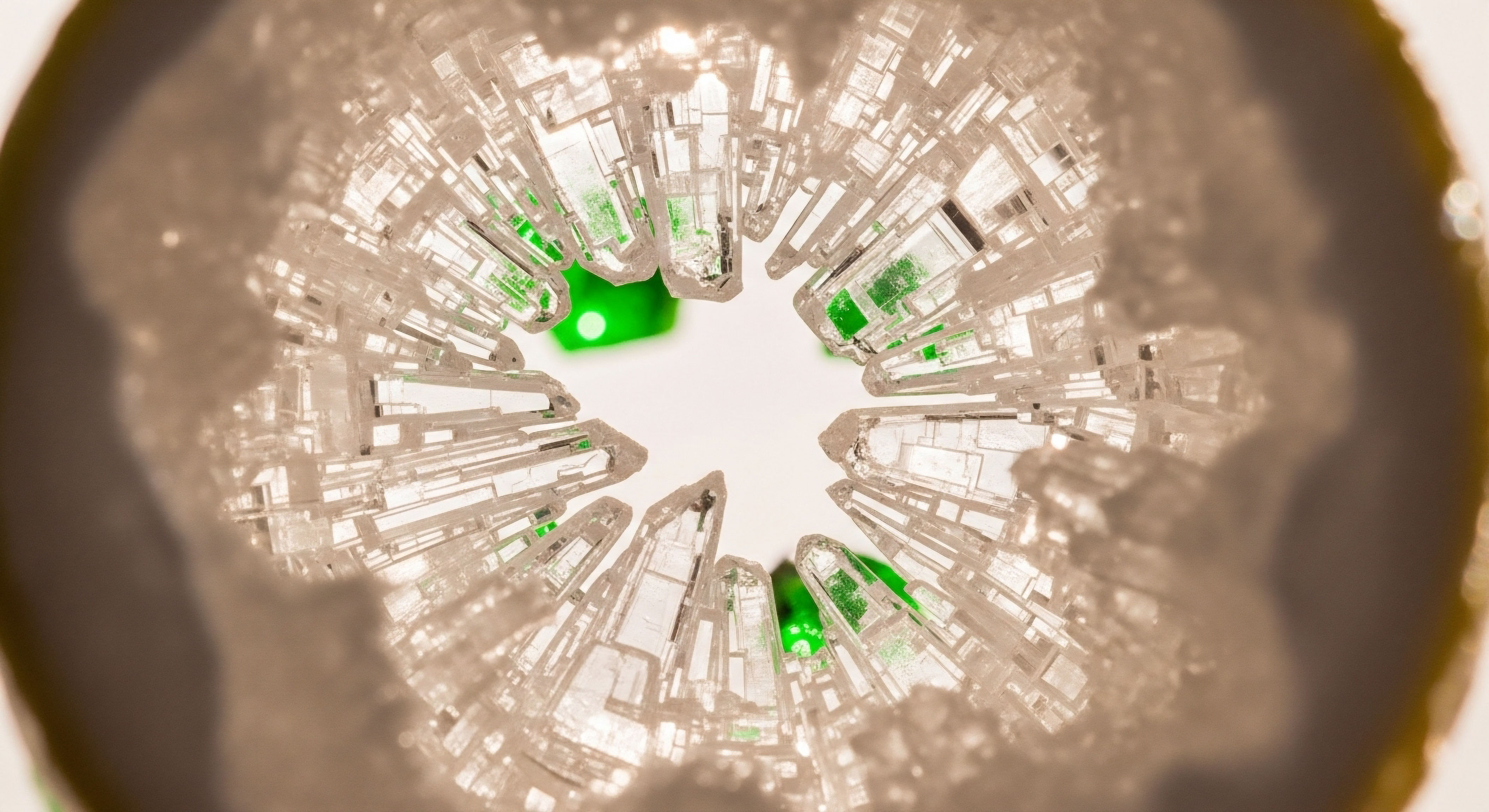

Fundamentals
You have embarked on a journey of biochemical recalibration. Whether you are utilizing Testosterone Replacement Therapy (TRT) to restore foundational hormonal levels or employing Growth Hormone Peptide Therapy like Sermorelin or CJC-1295/Ipamorelin to optimize cellular function, you are actively participating in the stewardship of your own physiology.
A central molecule in this process, the one that translates the signals from your therapy into tangible results like improved muscle integrity, heightened energy, and enhanced recovery, is Insulin-like Growth Factor 1, or IGF-1. Your decision to begin treatment was the first, significant step.
The next, equally profound step is to understand how your daily choices ∞ what you eat, how you move ∞ can profoundly influence the effectiveness of this powerful biological mediator. This is where you transition from being a passive recipient of a protocol to an active architect of your own well-being.
Imagine your body as a highly sophisticated construction project. Your therapeutic protocol, be it TRT or peptide therapy, acts as the master blueprint and the primary funding source. It authorizes the work and signals the overarching goal ∞ to build, repair, and revitalize.
Growth Hormone (GH), which your therapy either replaces or stimulates, is the project manager, traveling to the primary contractor ∞ the liver ∞ to issue the work orders. The liver, in response, produces and releases IGF-1.
This molecule is the foreman on the ground, the one that travels to every job site in your body, from muscle fibers to bone cells, and gives the direct command to grow and repair. It is the tangible agent of the anabolic, or building, processes you are seeking to enhance.
IGF-1 acts as the primary messenger that translates the instructions from Growth Hormone into direct cellular action for tissue repair and growth.
This is where your lifestyle choices become critical. The most well-funded project will stall if there are no raw materials on site. In this analogy, dietary protein represents the steel, concrete, and lumber required for construction.
When GH signals your liver to produce IGF-1, the liver requires a sufficient pool of amino acids, the building blocks of proteins, to assemble the IGF-1 molecule itself. A diet deficient in high-quality protein effectively starves the factory of its essential components.
Consequently, even with a strong hormonal signal from your therapy, IGF-1 production can be blunted, and the message for growth and repair is weakened before it is even sent. Providing your body with adequate protein is akin to ensuring a steady supply of high-quality materials is always available for the foreman to use.
Simultaneously, exercise functions as the team of specialized engineers and laborers who signal precisely where the building and repair work needs to happen most urgently. A sedentary body is like a construction site with no active work zones. The materials may be available, and the foreman may be ready, but there is no specific demand.
Physical activity, particularly resistance training, creates microscopic tears in muscle fibers. This sends a powerful localized signal for repair and reinforcement. It tells IGF-1 exactly where to focus its efforts, increasing the sensitivity of the local cellular machinery to its message. Your deliberate physical exertion creates the demand that your therapeutically-enhanced hormonal system is primed to meet.
By integrating purposeful nutrition and exercise into your protocol, you are creating a synergistic system where the therapeutic signal is robust, the necessary building blocks are abundant, and the directive for where to build is clear and precise. You are actively directing the flow of resources to achieve your desired outcome.


Intermediate
Advancing beyond the foundational understanding of IGF-1 reveals a more intricate system of checks, balances, and modulators. For an individual engaged in a hormonal optimization protocol, appreciating these subtleties is key to refining lifestyle inputs for maximum therapeutic benefit. The conversation moves from if diet and exercise have an effect, to how they specifically sculpt the IGF-1 landscape.
The type, timing, and intensity of your choices create distinct biological signals that can either amplify or attenuate the primary message delivered by your treatment.

The Dynamics of Protein Intake and IGF-1 Signaling
The relationship between protein consumption and IGF-1 levels is a direct and dose-dependent one. When you are on a therapy designed to increase Growth Hormone pulses, such as with Sermorelin or a CJC-1295/Ipamorelin blend, you are essentially increasing the frequency and amplitude of the signal telling the liver to produce IGF-1.
However, this production is entirely contingent on substrate availability, meaning the presence of essential amino acids. Studies have demonstrated that chronic elevations in dietary protein intake are associated with increased circulating IGF-1 concentrations. This occurs because a greater supply of amino acids not only provides the raw material for IGF-1 synthesis but also appears to enhance the liver’s sensitivity to the GH signal itself.
For the individual on a therapeutic protocol, this means a higher protein diet can act as a direct amplifier of the treatment’s primary mechanism. Consuming complete protein sources distributed throughout the day ensures that the liver is prepared to respond optimally to each GH pulse your therapy induces.

How Does Nutrient Timing Affect the IGF-1 Response?
The timing of nutrient intake, particularly protein, relative to exercise can create a powerful synergistic effect. Resistance exercise makes muscle cells more receptive to growth signals. Consuming a protein-rich meal within a few hours following a workout provides the necessary amino acids at the precise moment when muscle tissue is primed for uptake and repair.
This combination of stimulus (exercise) and substrate (protein) enhances the local anabolic environment. While a single high-protein meal can lead to a measurable increase in IGF-1 levels 24 hours later, combining it with exercise appears to create a more immediate and targeted effect on muscle protein synthesis, the very goal of many therapeutic interventions.

Exercise as a Potent IGF-1 Modulator
Different forms of exercise exert distinct effects on the GH/IGF-1 axis. The body does not interpret a long-distance run the same way it interprets a session of heavy squats. Understanding this distinction allows for the precise application of exercise as a tool to complement your therapy.
Resistance Training ∞ This form of exercise is a powerful stimulator of the GH/IGF-1 system. The mechanical tension placed on muscles during activities like weightlifting is thought to trigger three primary mechanisms ∞ it can increase the secretion of GH from the pituitary, stimulate the production of IGF-1 directly within the muscle tissue (known as autocrine/paracrine production), and enhance the sensitivity of IGF-1 receptors on muscle cells.
This means resistance training creates both a systemic and a highly localized anabolic signal, making it exceptionally synergistic with therapies aimed at increasing IGF-1 for muscle hypertrophy and repair.
High-Intensity Interval Training (HIIT) ∞ Sprinting and other forms of HIIT have also been shown to elevate IGF-1 concentrations. The intense metabolic stress of these workouts generates a significant GH response, which in turn drives hepatic IGF-1 production. HIIT can be a time-efficient method for generating a systemic anabolic signal.
Endurance Exercise ∞ In contrast, prolonged, steady-state endurance exercise has sometimes been shown to decrease or cause no significant change in IGF-1 levels. This may be related to the overall energy balance and metabolic state. During long-duration activities, the body may shift towards a more catabolic (breakdown) state to provide fuel, which can suppress the anabolic signals of the IGF-1 system.
This does not negate the cardiovascular benefits of endurance work, but it highlights the importance of selecting the appropriate exercise modality to align with specific therapeutic goals related to IGF-1.
The type of physical exercise performed acts as a specific instruction, directing the body to either amplify or temper the IGF-1 response systemically and locally.
| Exercise Modality | Primary Effect on IGF-1 | Key Biological Mechanism | Synergy with Peptide Therapy |
|---|---|---|---|
| Resistance Training | Significant Increase | Increased GH secretion, local muscle IGF-1 production, and enhanced receptor sensitivity. | High. Directly complements the goal of muscle hypertrophy and repair by creating local demand. |
| High-Intensity Interval Training (HIIT) | Moderate to Significant Increase | Strong stimulation of pituitary GH release due to high metabolic stress. | Moderate to High. Provides a strong systemic anabolic signal. |
| Low-Intensity Steady State (LISS) Endurance | Variable (Decrease or No Change) | Potential for negative energy balance and increased catabolic signaling during prolonged sessions. | Low to Neutral. Primarily benefits cardiovascular health, with less direct anabolic synergy. |

The Critical Intersection with Insulin Sensitivity
Insulin and IGF-1 are structurally similar and share signaling pathways. Optimal insulin sensitivity is a prerequisite for a robust IGF-1 response. A state of insulin resistance, often driven by a diet high in processed carbohydrates and a sedentary lifestyle, can blunt the liver’s ability to respond to GH.
It can also impair the ability of target cells throughout the body to respond to IGF-1. Therefore, lifestyle choices that improve insulin sensitivity directly support the efficacy of your hormonal therapy. These include:
- Macronutrient Balance ∞ Ensuring meals contain a balance of protein, healthy fats, and complex carbohydrates to prevent sharp spikes in blood glucose.
- Fiber Intake ∞ Consuming ample fiber from vegetables, legumes, and whole grains slows glucose absorption and improves insulin response.
- Consistent Sleep ∞ Chronic sleep deprivation is a known cause of insulin resistance, directly undermining your therapeutic goals.
- Stress Management ∞ High levels of the stress hormone cortisol can promote insulin resistance. Practices that manage stress are physiologically beneficial.
By managing these factors, you are ensuring the entire signaling cascade, from the peptide injection to the final action of IGF-1 on the cell, is functioning in a clear and efficient physiological environment. You are removing the static and allowing the signal to be heard.


Academic
A comprehensive analysis of how lifestyle factors modulate IGF-1 during hormonal therapies requires moving beyond circulating levels and into the complex regulatory network of binding proteins, receptor sensitivity, and intracellular signaling pathways. For the individual on a sophisticated protocol such as TRT or peptide therapy, the ultimate biological outcome is determined by this intricate system.
The total concentration of IGF-1 in the serum is just one variable in a much larger equation. The true efficacy of the therapy is dictated by the bioavailability of IGF-1 and the fidelity of the signal transduction at the target cell.

The Central Role of IGF-1 Binding Proteins
The majority of circulating IGF-1, over 99%, is not freely available. It is bound to a family of six high-affinity IGF-binding proteins (IGFBPs), with IGFBP-3 being the most abundant. These proteins are far more than simple carriers; they are dynamic regulators that control the half-life, transport, and bioavailability of IGF-1.
Their levels and activity are independently regulated by various metabolic and hormonal signals, providing a sophisticated layer of control over the IGF-1 system. Lifestyle factors, particularly nutrition and exercise, exert a profound influence on this binding protein network.

How Do Diet and Exercise Modulate Specific IGFBPs?
The interplay between insulin, IGFBPs, and IGF-1 bioavailability is particularly relevant. Insulin is a primary suppressor of IGFBP-1 synthesis in the liver. In a fasted state, insulin levels are low, leading to high levels of circulating IGFBP-1. This protein sequesters IGF-1, reducing its immediate bioavailability.
Following a meal, the subsequent insulin spike rapidly suppresses IGFBP-1 production. This action releases IGF-1 from its bound state, increasing the concentration of “free” IGF-1 available to interact with cellular receptors. Therefore, dietary patterns directly manipulate IGF-1 activity on an hour-by-hour basis by modulating IGFBP-1. Aerobic exercise training has been shown to increase basal concentrations of IGFBP-1, which may be one mechanism through which it confers metabolic benefits, potentially by fine-tuning IGF-1 signaling.
IGFBP-3, the main carrier protein, is itself GH-dependent. Therapies that increase GH levels, like Sermorelin or CJC-1295, will also increase IGFBP-3, forming a large ternary complex in the blood that acts as a circulating reservoir of IGF-1. This extends the half-life of IGF-1 and ensures a stable, sustained supply.
The nuance is that while the reservoir is larger, the amount of free, active IGF-1 is still tightly regulated by factors like IGFBP-1 and local tissue proteases that can cleave IGFBPs to release IGF-1 at specific sites of demand, such as a muscle recovering from exercise.
The bioavailability of IGF-1, governed by its binding proteins, is the critical variable determining its physiological impact at the cellular level.
| Binding Protein | Primary Regulator | Effect of Regulator | Modulated by Lifestyle | Primary Function |
|---|---|---|---|---|
| IGFBP-1 | Insulin | Inhibitory | High (Fasting increases it; meals decrease it. Aerobic exercise can increase basal levels.) | Rapidly modulates free IGF-1 bioavailability based on metabolic state. |
| IGFBP-2 | Insulin | Inhibitory | Moderate (Influenced by caloric restriction.) | Also involved in metabolic regulation; often elevated in catabolic states. |
| IGFBP-3 | Growth Hormone (GH) | Stimulatory | Low (Primarily driven by GH status.) | Forms a large circulating reservoir, extending the half-life of IGF-1. |

Cellular Mechanisms IGF-1 Receptor Sensitivity
Even with optimal free IGF-1 levels, the final outcome depends on the sensitivity of the target cell’s IGF-1 receptor (IGF-1R) and the integrity of its downstream signaling. The primary anabolic effects of IGF-1 in muscle are mediated through the phosphatidylinositol 3-kinase (PI3K)/Akt/mammalian target of rapamycin (mTOR) pathway. Activation of this cascade stimulates protein synthesis and inhibits protein breakdown. Lifestyle factors are potent modulators of this pathway’s efficiency.
For instance, chronic systemic inflammation, which can be exacerbated by a pro-inflammatory diet (high in processed foods, trans fats, and sugar) and a sedentary lifestyle, can induce a state of “anabolic resistance.” Inflammatory cytokines can interfere with key nodes in the PI3K/Akt pathway, effectively deafening the cell to the anabolic signal of IGF-1.
Conversely, factors like the omega-3 fatty acids found in fish oil and the mechanical loading from resistance exercise are known to enhance the sensitivity of this pathway. Thus, an anti-inflammatory diet and consistent training do more than just affect hormone levels; they prime the cellular machinery to respond more robustly to the IGF-1 that is present, maximizing the return on the therapeutic investment.

A Systems Biology Perspective on Therapeutic Synergy
To synthesize these concepts, consider the complete biological cascade for an individual using a CJC-1295/Ipamorelin combination, a protocol designed to generate a strong, clean GH pulse. The following sequence illustrates the intervention points for lifestyle choices:
- Signal Initiation ∞ The peptide therapy stimulates a significant GH pulse from the pituitary gland. This is the foundational therapeutic action.
- Hepatic Response & Substrate Availability ∞ GH travels to the liver and signals for IGF-1 production. The efficiency of this synthesis is directly dependent on the availability of amino acids from dietary protein. A high-protein diet ensures the factory is fully supplied.
- IGFBP Modulation & Bioavailability ∞ As IGF-1 enters circulation, its bioavailability is immediately governed by the IGFBP milieu. A recent meal will have suppressed IGFBP-1, increasing the proportion of free IGF-1. Consistent aerobic fitness may contribute to a healthier baseline IGFBP-1 level, improving overall metabolic regulation.
- Localized Demand & Receptor Sensitization ∞ A resistance training session has created microtrauma in specific muscle groups. This local environment experiences increased blood flow and heightened IGF-1R sensitivity. Local proteases may also be cleaving IGF-1 from its binding proteins, further increasing local availability.
- Signal Transduction ∞ The free IGF-1 binds to the sensitized IGF-1R on the muscle cell surface. The integrity of the intracellular PI3K/Akt/mTOR pathway, supported by an anti-inflammatory diet and good insulin sensitivity, allows for a high-fidelity transduction of the anabolic signal.
- Biological Outcome ∞ The cascade culminates in increased muscle protein synthesis and inhibited proteolysis, leading to hypertrophy and enhanced recovery. This outcome is a direct result of the synergy between the therapeutic signal and the environment created by precise lifestyle interventions.
This systems-level view demonstrates that diet and exercise are not merely adjuncts to hormonal therapy. They are integral components that actively shape the signaling environment at every stage, from hormone synthesis to intracellular action. They are the factors that determine the ultimate physiological and clinical result of the treatment.

References
- Yakar, Shoshana, et al. “40 YEARS OF IGF1 ∞ Role of IGF-binding proteins in regulating IGF responses to changes in metabolism.” Journal of Molecular Endocrinology, vol. 61, no. 1, 2018, pp. T115-T125.
- Gulick, D. T. et al. “Exercise, Dietary Protein, and Combined Effect on IGF-1.” The Journal of Strength & Conditioning Research, vol. 34, no. 9, 2020, pp. 2487-2493.
- Yoshida, T. and P. Delafontaine. “Mechanisms of IGF-1-Mediated Regulation of Skeletal Muscle Hypertrophy and Atrophy.” Cells, vol. 9, no. 9, 2020, p. 1970.
- Healy, M.L. et al. “High-Fat Meal and Aerobic Exercise Training Elicit Similar Reductions in Postprandial Lipemia and Insulinemia in Overweight, Older Adults.” Journal of the American College of Nutrition, vol. 31, no. 2, 2012, pp. 120-127.
- Nindl, B. C. et al. “Insulin-Like Growth Factor I, Its Binding Proteins, and Their Relation to Muscle Mass and Power in Elite Women Athletes.” Journal of Clinical Endocrinology & Metabolism, vol. 91, no. 11, 2006, pp. 4390-4396.
- Yau, W. M. et al. “American Association of Clinical Endocrinologists and American College of Endocrinology Guidelines for Management of Growth Hormone Deficiency in Adults and Patients Transitioning from Pediatric to Adult Care.” Endocrine Practice, vol. 25, no. 11, 2019, pp. 1191-1232.
- Katznelson, L. et al. “Acromegaly ∞ An Endocrine Society Clinical Practice Guideline.” The Journal of Clinical Endocrinology & Metabolism, vol. 99, no. 11, 2014, pp. 3933-3951.
- Schaefer, F. et al. “Growth Hormone and Insulin-Like Growth Factor-I Treatment in Children and Adolescents ∞ Growth Hormone Deficiency, Idiopathic Short Stature, and Primary Insulin-Like Growth Factor-I Deficiency.” Hormone Research in Paediatrics, vol. 86, no. 6, 2016, pp. 361-397.
- Varewijck, A. J. and E. C. M. Janssens. “The role of the GH/IGF-1 axis in the pathophysiology of age-related diseases.” Growth Hormone & IGF Research, vol. 22, no. 5-6, 2012, pp. 177-184.
- Bidlingmaier, M. and Z. Wu. “Growth Hormone.” Handbook of Hormones, 2nd ed. Academic Press, 2021, pp. 219-221.

Reflection
The information presented here provides a map of the intricate biological landscape you are navigating. It details the pathways, the signals, and the key intersections where your choices exert their influence. This knowledge transforms the daily acts of eating and moving from routine habits into precise tools for biological optimization. You now have a deeper appreciation for your body as a responsive, dynamic system ∞ one that is constantly listening and adapting to the signals you provide.
Consider your own protocol and your daily practices. Where are the points of synergy? Where are the opportunities for greater alignment? This understanding is the foundation upon which a truly personalized and effective wellness strategy is built. The journey toward reclaiming your vitality is a partnership between targeted clinical science and your own informed, deliberate actions. The power to direct the outcome resides within that collaboration.



